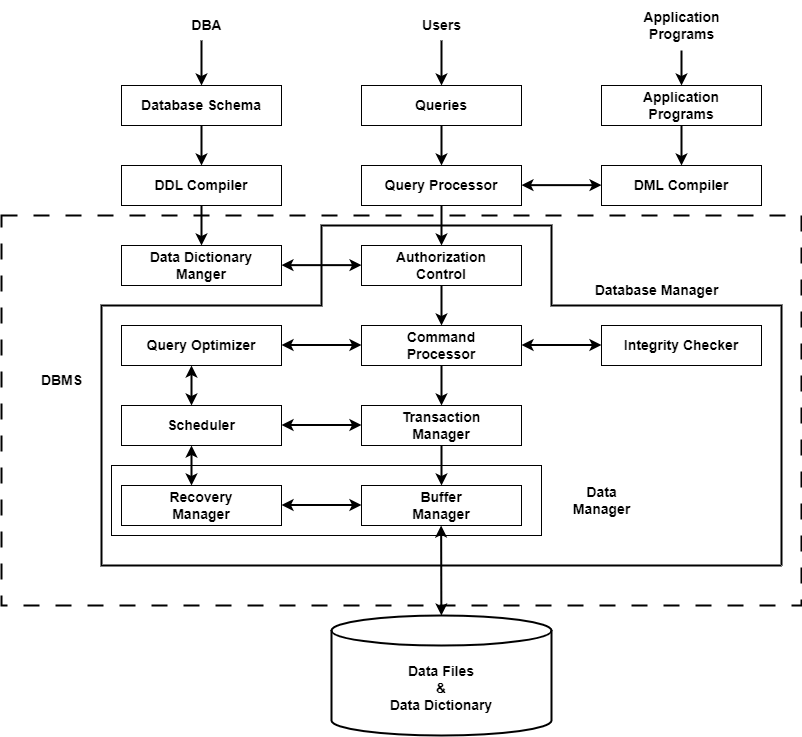Structure of DBMSDBMSDBMS means Database Management System, which is a tool or software used to create the database or delete or manipulate the database. A software programme created to store, retrieve, query, and manage data is known as a Database Management System (DBMS). Data can be generated, read, updated, and destroyed by authorized entities thanks to user interfaces (UIs). Because they give programmers, Database Managers, and end users a consolidated view of the data, Database Management Systems are crucial because they relieve applications and end users of the need to comprehend the physical location of the data. Application Programme Interfaces (APIs) manage internet requests and responses for particular sorts of data. In marketing materials, the phrase "database as a service" (DBaaS) may be used to refer to both relational and non-relational DBMS components that are given via the internet. Users of DBMSs include application programmers, Database Administrators (DBAs), and end users. Database Administrators are typically the only people who work directly with a DBMS. Today, end users read and write to databases using front-end interfaces made by programmers, while programmers use cloud APIs to connect with DBMSs. 
Three Parts that make up the Database System are:
The explanations for these are provided below: 1. Query ProcessorThe query processing is handled by the query processor, as the name implies. It executes the user's query, to put it simply. In this way, the query processor aids the database system in making data access simple and easy. The query processor's primary duty is to successfully execute the query. The Query Processor transforms (or interprets) the user's application program-provided requests into instructions that a computer can understand. Components of the Query Processor
Data Definition Language is what DDL stands for. As implied by the name, the DDL Interpreter interprets DDL statements like those used in schema definitions (such as create, remove, etc.). This interpretation yields a set of tables that include the meta-data (data of data) that is kept in the data dictionary. Metadata may be stored in a data dictionary. In essence, it is a part of the disc storage that will be covered in a later section of this article.
Compiler for DML Data Manipulation Language is what DML stands for. In keeping with its name, the DML Compiler converts DML statements like select, update, and delete into low-level instructions or simply machine-readable object code, to enable execution. The optimization of queries is another function of the DML compiler. Since a single question can typically be translated into a number of evaluation plans. As a result, some optimization is needed to select the evaluation plan with the lowest cost out of all the options. This process, known as query optimization, is exclusively carried out by the DML compiler. Simply put, query optimization determines the most effective technique to carry out a query.
Before the query evaluation, the embedded DML commands in the application program (such as SELECT, FROM, etc., in SQL) must be pre-compiled into standard procedural calls (program instructions that the host language can understand). Therefore, the DML statements which are embedded in an application program must be converted into routine calls by the Embedded DML Pre-compiler.
It starts by taking the evaluation plan for the question, runs it, and then returns the result. Simply said, the query evaluation engine evaluates the SQL commands used to access the database's contents before returning the result of the query. In a nutshell, it is in charge of analyzing the queries and running the object code that the DML Compiler produces. Apache Drill, Presto, and other Query Evaluation Engines are a few examples. 2. Storage Manager:An application called Storage Manager acts as a conduit between the queries made and the data kept in the database. Another name for it is Database Control System. By applying the restrictions and running the DCL instructions, it keeps the database's consistency and integrity. It is in charge of retrieving, storing, updating, and removing data from the database. Components of Storage ManagerFollowing are the components of Storage Manager:
Whenever there is any change in the database, the Integrity manager will manage the integrity constraints.
Authorization manager verifies the user that he is valid and authenticated for the specific query or request.
All the files and data structure of the database are managed by this component.
It is responsible for making the database consistent before and after the transactions. Concurrent processes are generally controlled by this component.
The transfer of data between primary and main memory and managing the cache memory is done by the buffer manager. 3. Disk StorageA DBMS can use various kinds of Data Structures as a part of physical system implementation in the form of disk storage. Components of Disk StorageFollowing are the components of Disk Manager:
It contains the metadata (data of data), which means each object of the database has some information about its structure. So, it creates a repository which contains the details about the structure of the database object.
This component stores the data in the files.
These indices are used to access and retrieve the data in a very fast and efficient way.
Next TopicConsistency in DBMS
|
 For Videos Join Our Youtube Channel: Join Now
For Videos Join Our Youtube Channel: Join Now
Feedback
- Send your Feedback to [email protected]
Help Others, Please Share









